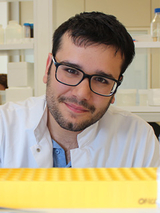Researchers at Children’s Hospital of Philadelphia (CHOP) demonstrated a promising new approach in the fight against high-risk neuroblastoma, a common and potentially deadly childhood cancer that can occur within the peripheral nervous system. The study, recently published in Nature Communications, found that chimeric antigen receptor (CAR) T-cell therapy targeting two markers on neuroblastoma cancer cells simultaneously boosted overall immune response by engaging adaptive and innate immunity in preclinical models.
In the United States, about 800 new cases of neuroblastoma are diagnosed each year, more often in boys. The average age of diagnosis is about 18 months but occasionally the disease is seen in teens and young adults.

The research was conducted by a collaborative team led by Kristopher R. Bosse, MD, an Attending Physician in the Division of Oncology at CHOP. His team recently identified Glypican-2 (GPC2), a protein, as a surface marker on neuroblastoma tumors that is not found on essential normal tissues. GPC2 promotes tumor growth and is regulated by the MYCN gene.
The researchers previously developed targeted therapies, including CAR-T and antibody-drug conjugates, to attack GPC2, with one CAR-T currently in a clinical trial. While a CAR-T approach showed strong anti-tumor effect in preclinical models, researchers found that some tumors can evade detection by lowering GPC2 levels, potentially leading to relapse.
“Our dual-targeting approach may help overcome the issue of antigen escape, a common mechanism of resistance to CAR-T cell therapies,” said Bosse, who is also an Assistant Professor of Pediatrics at the Perelman School of Medicine at the University of Pennsylvania. “This strategy allows the therapy to retain maximum efficiency even when some of the tumor cells avoid detection during treatment.”
In the study, researchers engineered T-cells to express a GPC2-directed CAR and secrete a bispecific innate immune cell engager (BiCE) to target both the disialoganglioside GD2 on tumor cells and CD16a on immune cells, activating innate immune cells like natural killer (NK) cells and macrophages to attack neuroblastoma cells. This approach reduced tumor growth, increased NK retention within the tumor microenvironment, and showed a lower risk of off-target effects compared to current GD2-targeted therapies, which can cause side effects such as neuropathic pain and immune reactions.

“This innovative CAR-T strategy represents a significant advance in the development of safer and more effective treatments for high-risk neuroblastoma,” said Guillem Pascual-Pasto, PhD, first author of the study and a scientist in the Bosse Laboratory at CHOP. “Next steps will be to conduct human clinical trials to determine if these promising, next-generation and combination immunotherapies can have lifesaving potential for children.”
Pascual-Pasto, G., McIntyre, B., Hines, M.G. et al. “CAR T-cell-mediated delivery of bispecific innate immune cell engagers for neuroblastoma.” Nat Commun. Online August 21, 2024. DOI: 10.1038/s41467-024-51337-2.
Featured in this article
Specialties & Programs
Researchers at Children’s Hospital of Philadelphia (CHOP) demonstrated a promising new approach in the fight against high-risk neuroblastoma, a common and potentially deadly childhood cancer that can occur within the peripheral nervous system. The study, recently published in Nature Communications, found that chimeric antigen receptor (CAR) T-cell therapy targeting two markers on neuroblastoma cancer cells simultaneously boosted overall immune response by engaging adaptive and innate immunity in preclinical models.
In the United States, about 800 new cases of neuroblastoma are diagnosed each year, more often in boys. The average age of diagnosis is about 18 months but occasionally the disease is seen in teens and young adults.

The research was conducted by a collaborative team led by Kristopher R. Bosse, MD, an Attending Physician in the Division of Oncology at CHOP. His team recently identified Glypican-2 (GPC2), a protein, as a surface marker on neuroblastoma tumors that is not found on essential normal tissues. GPC2 promotes tumor growth and is regulated by the MYCN gene.
The researchers previously developed targeted therapies, including CAR-T and antibody-drug conjugates, to attack GPC2, with one CAR-T currently in a clinical trial. While a CAR-T approach showed strong anti-tumor effect in preclinical models, researchers found that some tumors can evade detection by lowering GPC2 levels, potentially leading to relapse.
“Our dual-targeting approach may help overcome the issue of antigen escape, a common mechanism of resistance to CAR-T cell therapies,” said Bosse, who is also an Assistant Professor of Pediatrics at the Perelman School of Medicine at the University of Pennsylvania. “This strategy allows the therapy to retain maximum efficiency even when some of the tumor cells avoid detection during treatment.”
In the study, researchers engineered T-cells to express a GPC2-directed CAR and secrete a bispecific innate immune cell engager (BiCE) to target both the disialoganglioside GD2 on tumor cells and CD16a on immune cells, activating innate immune cells like natural killer (NK) cells and macrophages to attack neuroblastoma cells. This approach reduced tumor growth, increased NK retention within the tumor microenvironment, and showed a lower risk of off-target effects compared to current GD2-targeted therapies, which can cause side effects such as neuropathic pain and immune reactions.

“This innovative CAR-T strategy represents a significant advance in the development of safer and more effective treatments for high-risk neuroblastoma,” said Guillem Pascual-Pasto, PhD, first author of the study and a scientist in the Bosse Laboratory at CHOP. “Next steps will be to conduct human clinical trials to determine if these promising, next-generation and combination immunotherapies can have lifesaving potential for children.”
Pascual-Pasto, G., McIntyre, B., Hines, M.G. et al. “CAR T-cell-mediated delivery of bispecific innate immune cell engagers for neuroblastoma.” Nat Commun. Online August 21, 2024. DOI: 10.1038/s41467-024-51337-2.
Contact us
Jennifer Lee
Cancer Center